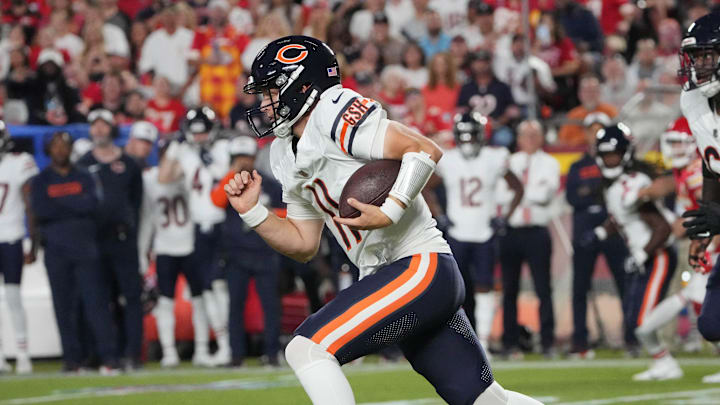Who Does the 'GSH' Patch on Bears' Jerseys Honor?

The Chicago Bears have a storied history as one of the NFL's founding franchises. Despite more than 100 years in existence, some fans don't know all of that history, including what the uniform patch with "GSH" written on it symbolizes.
We'll explore that in this article.
What does GSH patch on Bears uniforms mean?
The GHS lettering appears on all Bears uniforms including, for the first time in 2024, the team's 1936 throwbacks. The patch honors George Stanley Halas Sr., the team's founder and first owner. When he died in 1983, the team added a patch honoring him to its uniforms and it has stayed ever since.
Halas was a former professional baseball player, then player-coach for the Decatur Staleys, which were later renamed the Chicago Bears.
Who was George Halas?
Halas was born in Chicago, and had a diverse sports career. He attended the University of Illinois and played football and baseball. In 1918 he helped Illinois win the Big Ten title in football. While serving as an ensign in the Navy during World War I, he played for the Great Lakes Navy Bluejackets and was named MVP of the 1919 Rose Bowl. He was later inducted into the Rose Bowl Hall of Fame.
Halas played minor league baseball and was eventually called up to the New York Yankees as an outfielder where he played 12 games. According to Halas, Babe Ruth later replaced him as the Yankees' right fielder. A hip injury ended his baseball career.
Hallas took a job with the A. E. Staley Company and played on the company-sponsored football team, the Decatur Staleys. He represented the team at the 1920 meeting that formed the American Professional Football Association, which became the NFL two years later.
After the Staleys' first game of the 1921 season, company founder Augustus E. Staley turned over full control of the team to Halas and he moved the franchise to Chicago. He was required to keep the franchise name for the 1921 campaign. The Chicago Staleys played at what would eventually become Wrigley Field and won their first NFL championship that season.
Halas coached the team but also played wide receiver and defensive end while also running the franchise. He was named to the NFL's 1920s All-Decade Team. He retired from playing and coaching in 1930 but remained as the team's owner. He took up coaching duties again in 1933 and remained until 1942, leading the Bears to championships in 1933, 1940, and 1941.
Halas served in World War II, then eventually returned to coach the team again beginning in 1946 and staying through 1955, winning a championship in 1946. After a short break, he was back on the sidelines guiding the team from 1958 through 1967. During that stint, the Bears won the 1963 NFL championship, and Halas was named AP Coach of the Year in 1963 and 1965.
After that, he stepped back from coaching and remained the team's owner until he died in 1983 at the age of 88. Overall as a head coach, he went 318-148-31, a .671 winning percentage. His teams also won six NFL championships. In 40 seasons as a head coach, he only suffered six losing seasons.
The NFC Championship trophy is named in Halas's honor and he was a charter member of the Pro Football Hall of Fame in 1963.
Who owns the Chicago Bears?
Halas's family still owns the Bears to this day. His oldest daughter, Virginia Halas McCaskey inherited ownership of the franchise when Halas died in 1983. She is 101 years old and her son, George Halas McCaskey is the team's current chairman.
